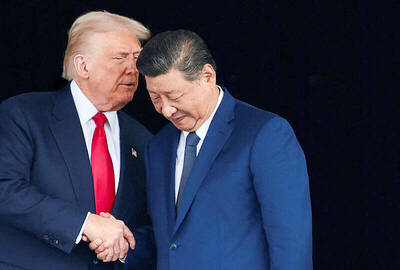The New Taiwan dollar rose on Friday, strengthening in tandem with currencies and shares across Asia’s developing nations, as signs that the global financial crisis is easing bolstered demand for emerging-market assets.
The currency has gained about 7 percent against the US dollar since reaching an eight-year low of NT$35.297 in March. The US Federal Reserve said on Thursday it would end one emergency funding program and scale back two others, a sign markets are stabilizing after banks worldwide reported credit losses of almost US$1.5 trillion in the past two years. Overseas investors added to their holdings of Taiwan stocks for a third day.
The Fed announcement “tells us that financial conditions are normalizing; it’s a confirmation of sentiment,” said Dwyfor Evans, a currency strategist at State Street Global Markets in Hong Kong. “The big picture is still in place, one of continued inflows into Taiwan, benefits from the relationship with China, and also continued benefits from what is still a risk-loving environment.”
The NT dollar rose 0.1 percent to close at NT$32.925 on Friday, according to Taipei Forex Inc. The currency will climb to NT$31.50 by the end of the year, Evans forecast.
Elsewhere, Indonesia’s rupiah and the Philippine peso had a weekly gain on optimism overseas investors will buy Asian bonds and stocks after the US Federal Reserve signaled US interest rates will be kept at near zero.
The rupiah was the biggest gainer this week among Asia’s 10 most-active currencies outside Japan as its 10-year bond yielded 7.6 percentage points more than similar-dated US debt, near the highest in a month.
The rupiah climbed 1.8 percent this week to 10,220 per US dollar in Jakarta on Friday, according to data compiled by Bloomberg. The peso rose 0.2 percent to 48.305 in Manila, according to Tullett Prebon PLC. The Thai baht rose 0.3 percent to 34.07.
The South Korean won fell 1.2 percent this week to 1,284.25 against the US currency, the Vietnamese dong was barely changed at 17,802 and Singapore’s dollar was little changed at S$1.4542.
The US dollar fell against most of its major counterparts after China repeated its call for a supranational currency “delinked” from sovereign nations.
The greenback headed for its biggest weekly loss against the euro in four weeks after the People’s Bank of China said the IMF should manage more of members’ foreign-exchange reserves. A rally in Treasuries this week pushed the yield on the benchmark 10-year note down the most since December, lowering expected returns.
The US currency declined 0.6 percent to US$1.4078 per euro at 3pm in New York, from US$1.3988 on Thursday, extending its loss for the week to 1 percent. The dollar fell 0.8 percent to ¥95.17 from ¥95.95 on Thursday and was poised for a 1.1 percent weekly decline, its third consecutive drop.
The Swiss franc rose against the euro and dollar on speculation traders will test the central bank’s resolve to keep its currency weaker.
The franc climbed 0.6 percent to SF1.5219 against the euro, one of only five major currencies to advance on Friday versus Europe’s 16-nation currency. The franc advanced 1.2 percent to SF1.0814 compared with the US dollar.

CALL FOR SUPPORT: President William Lai called on lawmakers across party lines to ensure the livelihood of Taiwanese and that national security is protected President William Lai (賴清德) yesterday called for bipartisan support for Taiwan’s investment in self-defense capabilities at the christening and launch of two coast guard vessels at CSBC Corp, Taiwan’s (台灣國際造船) shipyard in Kaohsiung. The Taipei (台北) is the fourth and final ship of the Chiayi-class offshore patrol vessels, and the Siraya (西拉雅) is the Coast Guard Administration’s (CGA) first-ever ocean patrol vessel, the government said. The Taipei is the fourth and final ship of the Chiayi-class offshore patrol vessels with a displacement of about 4,000 tonnes, Lai said. This ship class was ordered as a result of former president Tsai Ing-wen’s (蔡英文) 2018

‘SECRETS’: While saying China would not attack during his presidency, Donald Trump declined to say how Washington would respond if Beijing were to take military action US President Donald Trump said that China would not take military action against Taiwan while he is president, as the Chinese leaders “know the consequences.” Trump made the statement during an interview on CBS’ 60 Minutes program that aired on Sunday, a few days after his meeting with Chinese President Xi Jinping (習近平) in South Korea. “He [Xi] has openly said, and his people have openly said at meetings, ‘we would never do anything while President Trump is president,’ because they know the consequences,” Trump said in the interview. However, he repeatedly declined to say exactly how Washington would respond in

WARFARE: All sectors of society should recognize, unite, and collectively resist and condemn Beijing’s cross-border suppression, MAC Minister Chiu Chui-cheng said The number of Taiwanese detained because of legal affairs by Chinese authorities has tripled this year, as Beijing intensified its intimidation and division of Taiwanese by combining lawfare and cognitive warfare, the Mainland Affairs Council (MAC) said yesterday. MAC Minister Chiu Chui-cheng (邱垂正) made the statement in response to questions by Democratic Progressive Party (DPP) Legislator Puma Shen (沈柏洋) about the government’s response to counter Chinese public opinion warfare, lawfare and psychological warfare. Shen said he is also being investigated by China for promoting “Taiwanese independence.” He was referring to a report published on Tuesday last week by China’s state-run Xinhua news agency,

‘ADDITIONAL CONDITION’: Taiwan will work with like-minded countries to protect its right to participate in next year’s meeting, the foreign ministry said The US will “continue to press China for security arrangements and protocols that safeguard all participants when attending APEC meetings in China,” a US Department of State spokesperson said yesterday, after Beijing suggested that members must adhere to its “one China principle” to participate. “The United States insists on the full and equal participation of all APEC member economies — including Taiwan — consistent with APEC’s guidelines, rules and established practice, as affirmed by China in its offer to host in 2026,” the unnamed spokesperson said in response to media queries about China putting a “one China” principle condition on Taiwan’s